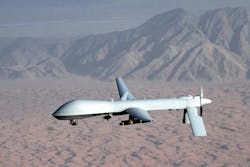Ever since Congress approved the FAA Modernization and Reform Act of 2012, which called for the agency to open up domestic airspace for unmanned aerial vehicles (UAVs), there has been an outcry from privacy advocates, as well as federal and state lawmakers to regulate how drones can and cannot be used. In the last month alone, bills have been introduced in North Carolina and Maine that would restrict the use of drones by law enforcement officials in those states. Just last week, legal experts told the U.S. Senate Judiciary Committee that current privacy laws need to be updated before UAVs take to the skies in mass over the next decade.
Lost in all the hysteria over privacy concerns, however, is that very few people have considered whether or not current civilian UAV technology is actually ready to create this Orwellian society that so many fear. There seems to be this misconception that because restrictions may be loosened by the FAA that drones along the lines of the U.S. Air Force’s Predator UAV will be roaming the skies above American cities. Many of the types of drones currently available to law enforcement are not as sophisticated as the ones used by the military.
“It takes a lot of infrastructure to support those types of drones,” said Ross McNutt, president of Persistent Surveillance Systems. “And those drones run 10s of millions of dollars for the drone itself and then the infrastructure to support that.”
According to McNutt, there are “very, very few” drones actually in use in the U.S and, for the most part, civilian UAVs have proven to be ineffective. McNutt said that most of these small, remote-controlled drones that are on the market would only be useful at ongoing crime scenes for finding suspects who may be hiding, but not for surveillance of larger areas.
Using manned, light aircraft outfitted with state-of-the-art camera technology, McNutt’s company provides a wide area surveillance solution to cities that can cover up to 25-square-miles. McNutt said his company is usually called in by a city that has suffered a crime spike to watch the troubled portion of the city based on crime reports.
“What we’re trying to do is identify crimes from police reports and 911 calls in a general area and be able to support the investigation of that crime by determining where the people who were involved in that crime came from and went to,” he explained. “So far, we’ve witnessed 34 murders as they occurred and have confessions that account for 75.”
In addition, McNutt said that aerial surveillance also offers tremendous cost benefits over traditional, ground-based camera systems. While a drone or police helicopter may focus in on a small area at a higher resolution, McNutt said his company’s technology enables law enforcement to view a wider area at a lower resolution, thereby allowing them to see crimes occurring in their jurisdictions on a much broader scale.
“They look at about three, four or five houses; whereas at much lower resolutions, we see a much larger area, allowing us to view 10 to 15 to 20 crimes a day with our system,” McNutt added.
Of course, the larger question is not so much about when and where drones can be used, but rather how do we balance privacy with the use of aerial surveillance solutions?
“Cameras have become so prevalent that whether or not it is a police video camera, a gas station camera or anything like that, people have come to accept that they are being recorded many, many times a day. What they don’t want to do is have that used inappropriately to figure out what they’re doing,” McNutt said. “And we’ve decided that the benefits of those cameras sort of outweigh the nuisance factor of what is happening. It really does come down to a value that the cameras provide versus the slight loss of a particular person’s privacy.”
That’s not to say, however, that providers of aerial surveillance solutions shouldn’t be concerned about privacy. McNutt said that his company has “a lot of privacy policies” and that they don’t “just pick people off the street and follow them.”
The arguments currently taking place at the federal and state level over the use of drones is not unlike those that have taken place through the years over municipal, ground-based surveillance networks. People’s fears about their use are also understandable, but potentially a bit overblown. Yes, it is a little disconcerting to think that your movements are being watched by an airborne robot or even a manned aircraft, but the fact is we’re being watched already as McNutt accurately points out – whether it is at an intersection or in a grocery store aisle. Like it or not, aerial surveillance appears to be the wave of the future, be it through the use of drones or a solution like that provided by McNutt’s company.
About the Author
Joel Griffin
Editor-in-Chief, SecurityInfoWatch.com
Joel Griffin is the Editor-in-Chief of SecurityInfoWatch.com, a business-to-business news website published by Endeavor Business Media that covers all aspects of the physical security industry. Joel has covered the security industry since May 2008 when he first joined the site as assistant editor. Prior to SecurityInfoWatch, Joel worked as a staff reporter for two years at the Newton Citizen, a daily newspaper located in the suburban Atlanta city of Covington, Ga.

